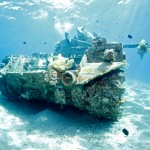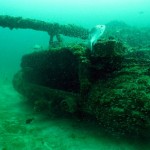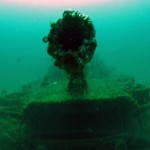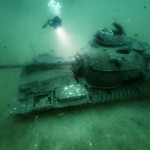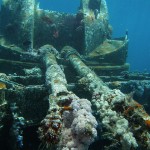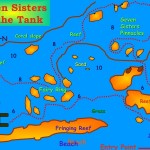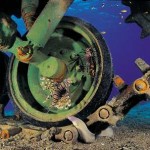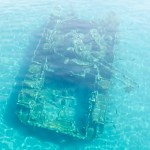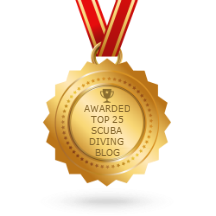Scuba TANKS
For most divers the words scuba and tank used together in the same sentence refers to an air filled aluminum or steel cylinder. For those into creating artificial reefs, “scuba tanks” refer to former military machines capable of firing multiple warheads and moving rapidly over any terrain by use of two independent tract like belts. Once the tanks have out lived their usefulness or have become obsolete by newer more powerful models, they are relegated to parking fields where they wait to be disposed of or turned into scrap. Alabama has taken the lead by sinking 100 M-60 tanks in nearby waters. Alabama was also the first to start artificial reef building when they sank 250 automobiles back in 1953. Alabama now has one of the best off shore fishing grounds for red snapper that range from 15 to 25lbs in weight and some 30 to 40% of all red snapper in the gulf are caught right off the shores of Alabama. The first six tanks were sunk here in 1987. They are expected to have a life span of 50 years and generate millions of dollars in revenue for the state from visiting fishermen and scuba divers. 6,000 M-48 and M-60 tanks used in Korea and Vietnam sit idle on military basis across the nation. At one point there were at least 3,000 tanks just at Anniston Army Depot in Alabama. Scraping the tanks would have cost millions, but fortunately, it costs a lot less to turn tanks into artificial reefs. Reserve units remove engines, transmissions, and fuel and hydraulic lines before the tanks are cleaned and ready for transportation. The main cost for States wanting the tanks for reefs is the actual cost of transportation. It’s not easy moving a 30ft long 8ft high 50 ton piece of former military might.
Florida has sunk two M-60 tanks in 48ft of depth off of Miami Beach that are now home to spiny oysters, lobster, sponges, and soft coral. Rock walls were also set up around the tanks. Florida wants to sink 100 tanks in total. Fans from seven other Florida counties want in on this hot deal. Back in 1993, Broward County applied for $60,000 in state money to help offset the costs of sinking 10 tanks in waters about 72ft deep. Besides steam cleaning, each tank has the hatches welded open and the engine grill is removed before it’s safe for fish and divers alike. The best thing about turning tanks into reefs is that tanks seem to be impervious against direct assaults by Mother Nature. When the artificial reef Spirit of Miami, a former 727 airplane, was hit by tropical storm Gordon in 1985, its aluminum tube design broke apart faster than fortune cookies at a Global Economic Summit. Military tanks on the other hand can get buried by sand, but will remain in tact for countless years of storms, hurricanes, and garden-variety falling meteorite driven tsunamis. The Japanese tanks sunk in Truk Lagoon during WWII have been sunk for over 70 years. With a known start date, these tanks/reefs besides looking surreal and reminding us of a major historical battle and the accompanying casualties, they can now be used to gauge individual coral growth as well as the growth of micro ecosystems over a fixed period of time and depth.
Now we should mention that the Tampa/ St. Petersburg area has 8-10 tanks around 50ft of depth, but they have upped the ante on the military side by sinking three barges in a rectangular grid of 300ft by 600ft at 42ft of depth and by placing a Lockheed Neptune P2V-3 plane directly in the center and calling it Veteran’s Reef. This area is also known for the world’s largest spear fishing tournament where we believe war relic reefs have only helped increase habitat space for smaller fish that the record size grouper, cobia, wahoo, hogfish, kingfish, mackerel, snapper, bonito, and wahoo feed on.
Off the coast of New York and New Jersey M-60’s, M-48’s, M-551’s and other armored personnel carriers were deployed straight over the sides of barges. Some of the M-551’s are right off of Jones Beach, Fire Island, and Atlantic Beach. The trouble with diving on the tanks in New York and New Jersey, is that you have to make a choice between some 58 or more tanks, or dive some more than 4000 known or potential shipwreck sites; some of which still harbor great glass and ceramic goodies as well as early American antique artifacts.
“Reef Exercise” (REEFEX) a joint Department of Defense and civilian groups operation is responsible for the tank to artificial reef program. Off the coast of Virginia they now have sunk armored personnel carriers and some 18 Sheridan tanks. Georgia has M-60 tanks out at Site F. South Carolina has tanks and other decommissioned vehicles such as M-113 track vehicles out at 39 different sites. The Jim Caudle Artificial Reef in Horry County, which is the most visited and most popular fishing reef in the state is said to generate between 15-20 million in annual economic revenue.
It’s not just in some of the seaside States where fish tanks are becoming popular. In Thailand, The Royal Thai Army donated 25 medium-sized Chinese made tanks to Her Majesty Queen Sirikit to be used in the Gulf of Thailand as part of her wish to “rejuvenate the oceans”.
In Jordan, an American made M-42 Duster with a self propelled anti-tank canon was reefed in 1999 by the Jordanian Royal Ecological Diving Society and is a highlight while diving a circuitous route at the Seven Sisters dive site.
We guess in the end that it only makes sense that one of the most powerful mobile military machines would also make one of the most rugged artificial reefs in the world. The return on investment especially for the fishing industry is a basic economic no brainer. The recent increase in local fish size and number of fish has exceeded most expectations. With a little more cleaning, a little more State or Federal funding, and a little more final submersible deployments, tanks and other military vehicles will become some of the most powerful protectors of our reefs and fish populations for generations to come.


